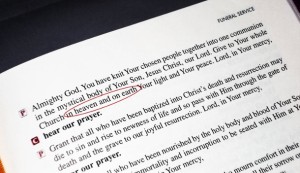 This is a lesson from our study of 2 Timothy. Paul mentioned that he prayed for a man named Onesiphorus, who most likely had died when Paul prayed for him. So, we look into this to see what we can learn.
This is a lesson from our study of 2 Timothy. Paul mentioned that he prayed for a man named Onesiphorus, who most likely had died when Paul prayed for him. So, we look into this to see what we can learn.
———–
Read 2 Timothy 1:16-17
- In what tense (past, present, or future) does Paul refer to Onesiphorus?
- Unlike some others who were ashamed of Paul, how had Onesiphorus treated him?
“he often refreshed me”: Onesiphorus seems to have died before Paul wrote 2 Timothy, for Paul mentions his family twice (here and in 2 Timothy 4:19), although it was Onesiphorus who had helped him in prison and served the congregation at Ephesus. Paul’s second mention of Onesiphorus is striking: He doesn’t ask Timothy to greet Onesiphorus but, instead, “Greet… the family of Onesiphorus” (2 Timothy 4:19).
Paul speaks of Onesiphorus’ earthly deeds in the past tense. Paul even praises “the service he rendered [past tense] at Ephesus,” without referring to any service that he is [present tense] rendering, there or elsewhere.
The most natural conclusion is that Onesiphorus had died. With such an understanding, Paul’s prayer in verse 16 makes all the more sense: “May the Lord grant mercy to the household of Onesiphorus” because Onesiphorus was no longer there.
Read 2 Timothy 1:18
- What does Paul do for Onesiphorus that many of us might find unusual today?
- What is “that Day” that Paul speaks of concerning Onesiphorus?
“may the Lord grant him”: Here, Paul speaks of Onesiphorus in the present and future tense. He prays, “May the Lord grant him to find mercy from the Lord on that Day!” Paul is praying for Onesiphorus after he died, leaving him to God’s mercy as they both anticipate Christ’s return, the final judgment, and the new creation.
This prayer is distinct from Paul’s prayer for Onesiphorus’ family in vs. 16. If Onesiphorus wasn’t dead, why did Paul pray for him and his family separately? This points to the most natural conclusion that Onesiphorus had died, and that Paul had prayed for him after he died.
Optional: Read John 11:17-27, 38-44 (Jesus Raises Lazarus from the Dead)
- What did Martha ask Jesus to do? (vs. 22)
- Based on the setting, what would Martha expect from Jesus’ prayer? (vs. 39)
- When Jesus chided Martha, was it because she (most likely) asked Jesus to pray for Lazarus who had died? (vs. 40)
Excursus: Prayers for the Sainted Dead
Historically, we know that Jews prayed for someone in God’s Covenant who had died. For we find can such a practice in 2 Maccabees 12:42-45 and Baruch 3:4. Even if one disagrees that those books are part of Scripture,[1] we still find that it was a practice within Judaism before the time of Christ. And that practice has continued to this day in Judaism, known as the “mourner’s kaddish.” Those prayers are offered after a family member dies, and the funeral El Male Rachamim is a prayer specifically for the soul of the deceased.
In Christianity, we find archeological evidence from inscriptions in the catacombs (dating from the 2nd century!) that testify to praying for the sainted dead. We also have writings from some Church fathers and other documents that show such prayers were simply part of the Church’s practice. For example, Church fathers Tertullian (160-225 AD), Cyril of Jerusalem (315-386 AD), and Ambrose (340-397 AD) speak of this practice. Canons of Hippolytus (336-340 AD) and Apostolic Constitutions (375-380 AD) also mention prayers for the dead, as well.
Prayers for the sainted dead was a Church practice from the beginning (that is, based on the few writings that we do have from the early Church). So, Church practice simply affirms the understanding that we, like Paul, pray for the sainted dead after they die.
The question is why?
If we pray only for what we can get God to do for ourselves or others, then prayers for the dead make no sense! After all, “people are destined to die once, and after that face judgment” (Hebrews 9:27). After a Christian dies, his soul is in heaven (Luke 23:43, Philippians 1:23, and 2 Corinthians 5:6, 8); he’s in heaven, awaiting his body to rejoin his soul on the Last Day.
The saints in heaven are still living in faith and hope, awaiting the reunion of body and soul. But this will happen even without our prayers! So, why bother praying for them? (One can also mistakenly conclude not to pray for anything here. After all, we know “that in all things God works for the good of those who love Him” [Romans 8:28], even without our prayers).
But if our prayers are motivated by more than what we would like God to do, then prayers for the sainted dead (actually, those whose souls are alive in heaven) make sense, just like prayers for the saints on earth do. To understand this better, we turn to the Lord’s Prayer, which Jesus gave His disciples to pray (Luke 11:2). It starts out, “Our Father.”
Nothing in Ephesians chapter 6 suggests that when Paul said to “pray for all the saints,” he was limiting that statement only to the saints on earth, which then would only be some of the saints.
Further, our Lutheran Confessions also say that praying for the sainted dead is beneficial (Apology to the Augsburg Confession, 24, paragraph 96).
Click here to go to the next Lesson.
[1] They were part of the Septuagint, which was the Greek-language Old Testament for Jesus and His Apostles.


